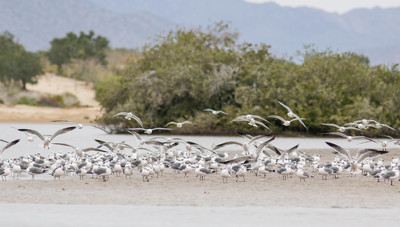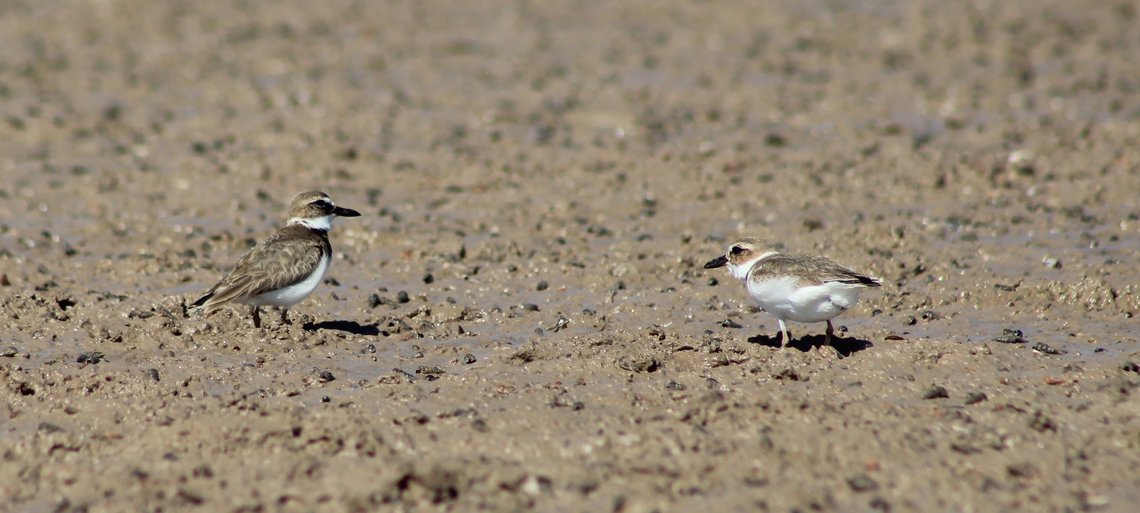By April Heredia Morales and Jaime Martínez Reyes, Co-Coordinators of the Waterbird Monitoring Program, Prescott Center A.C.
The conservation efforts at Estero La Cruz work as an assembly that have evolved along with the demands of the environment. Located in the small and picturesque coastal community of Bahia de Kino, Sonora, it is one of the most extensive wetlands on the central coast of the state. Yet, it often goes unnoticed by many who do not take the time to observe it. Human communities continue to take advantage of the available resources. The mosaic of habitats also provides shelter and the essential resources for fish, mollusks, crustaceans, sea turtles, and waterbirds to complete their life cycles. Estero La Cruz is, since 2013, the twelfth Ramsar site of the state for its importance to the conservation of global biodiversity.

Prescott College’s Kino Bay Center for Cultural and Ecological Studies has been leading the effort to monitor waterbirds in Estero La Cruz and the surrounding area for more than a decade, funded in part by the Sonoran Joint Venture. A diverse team of researchers who carry out the monitoring efforts represent the Waterbird Monitoring Program annually. Efforts begin in the fall, when groups of migratory shorebirds such as the Marbled Godwit, Long-billed Curlew, Willet, and Western Sandpiper feed on the tidal flats. Mixed congregations of California, Ring-billed, and Laughing Gulls use the exposed mudflats, as well as Forster’s and Caspian Terns, perhaps even the unusual Gull-billed Tern. Late arrivals include Brant, Red-breasted Merganser, American White Pelican, and sometimes dozens of Black Skimmers. To a lesser extent, Eared Grebe and Common Loon feed in the wetland, but their numbers increase as they cross the mouth of the estuary connecting it to the Gulf of California, one of the world’s most productive seas.

All of these birds arrive in different windows of time; the succession creating a show that extends throughout the season. As the time to fly to breeding sites in temperate, boreal and arctic regions of the northern hemisphere approaches, these visitors are relieved by other migrants or residents who will breed on islands in the Gulf of California, including Elegant Tern, Double-crested Cormorant, Brown Pelican, and Heermann’s Gull. Species like American Oystercatcher and Wilson’s Plover choose their nesting sites on the sandy and shell beaches in the estuary.
All these species use the estuary for their life activities. Conservation and sustainable resource management is critical at the site level. In this sense, the data obtained by the program over the years has supported the implementation of the Estero La Cruz Management Plan by the Center’s Wetlands Conservation Program. Currently, data on species richness and abundance of waterbirds are being analyzed to determine trends in bird numbers and seasonality over time. In addition, program members are involved in consulting and training community monitoring groups and leading educational activities about the biological and cultural richness of the site. Conservation actions are also important in a context of connectivity in the Pacific Flyway Corridor. The situation of species and their habitats in a site influences the dynamics of conservation actions. This is why knowing all this assembly of activities is of great importance for the conservation of Estero La Cruz.

